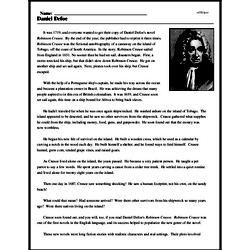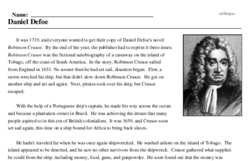Daniel Defoe
It was 1719, and everyone wanted to get their copy of Daniel Defoe's novel Robinson Crusoe. By the end of the year, the publisher had to reprint it three times. Robinson Crusoe was the fictional autobiography of a castaway on the island of Tobago, off the coast of South America. In the story, Robinson Crusoe sailed from England in 1651. No sooner than he had set sail, disasters began. First, a storm wrecked his ship, but that didn't slow down Robinson Crusoe. He got on another ship and set sail again. Next, pirates took over his ship, but Crusoe escaped.
With the help of a Portuguese ship's captain, he made his way across the ocean and became a plantation owner in Brazil. He was achieving the dream that many people aspired to in this era of British colonialism. It was 1659, and Crusoe soon set sail again, this time on a ship bound for Africa to bring back slaves.
He hadn't traveled far when he was once again shipwrecked. He washed ashore on the island of Tobago. The island appeared to be deserted, and he saw no other survivors from the shipwreck. Crusoe gathered what supplies he could from the ship, including money, food, guns, and gunpowder. He soon found out that the money was now worthless.
He began his new life of survival on the island. He built a wooden cross, which he used as a calendar by carving a notch in the wood each day. He built himself a shelter, and he found ways to feed himself. Crusoe hunted, grew corn, tended grape vines, and raised goats.




